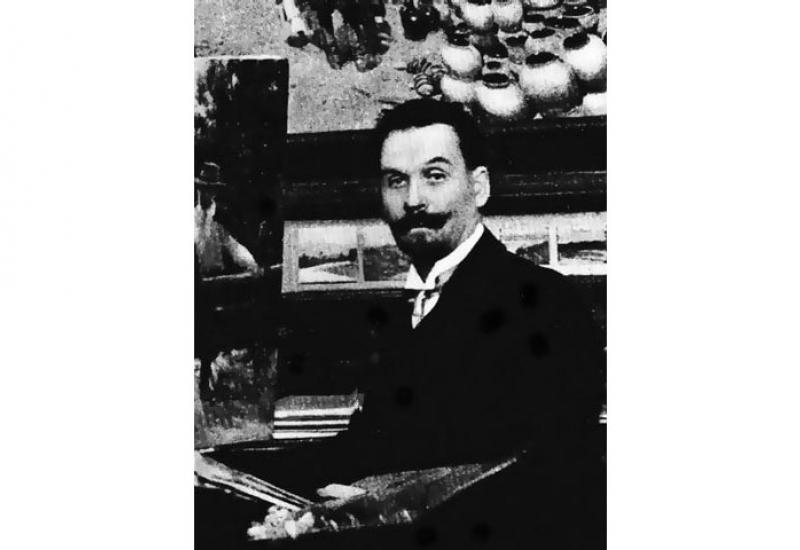Looking through the list of teachers who have worked at the Kyiv Polytechnic Institute in the early twentieth century, it is impossible not to draw attention to the name of a man who seemingly had nothing to do with technology and science – the painter Mykola Pymonenko.
Indeed, what could teach at a technical college prominent Ukrainian painter, whose works were already represented in the collections of many Russian and European museums and private collections, outstanding master of everyday genre and interesting portraitist, the member of the Association of Traveling Exhibitions and academician of the Imperial Academy of Arts?
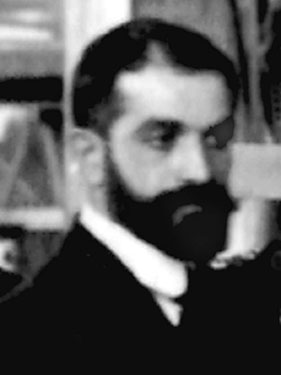
Of course, drawing! The course of drawing was mandatory primarily at training engineers building specialties. A department that trained such engineers (it is called - Engineering), was one of the first four that were open at the Kyiv Polytechnic Institute in its foundation. However drawing, or, more precisely, technical drawing, and it was a compulsory subject for future mechanical engineers - do not forget that the industrial design professionals in those days did not exist, so the question of external and ergonomic characteristics of their designs the then developers of new technology should do themselves. And it is very significant that, in order to allow students to learn as much as possible the basics of fine art, the first rector of KPI Victor Kirpichev invited to work at the institute one of the most famous Ukrainian painters, who, moreover, had a vast experience of teaching.
The pedagogical biography Mykola Kornylovych Pymonenko began at an early age, even in the years of his own learning. And do not interrupt this activity until the last days of life.
But all in order.
He was born March 9 (21 to Art. Style), 1862 on the picturesque outskirts of Kyiv Priorka. His father - Cornelius Danilovich Pymonenko had a small icon-painting workshop and worked with woodcarving. From the age of eleven, the future artist went with his father on near towns and villages, where the Pymonenko senior erected altars and made paintings of churches. These trips attached him to the work of his father and at the same time gave those first impressions that determine human perception of the world forever. For younger Pymonenko they have become a breeding source of love for his native land and its people, have formed the Ukrainian special look, thanks to which his works are extremely easy to distinguish from other works of his contemporaries. Pymonenko was a very national artist. And how to not believe in the wisdom of fate, if we remember that even his birthday coincides with the birthday of Taras Shevchenko! .
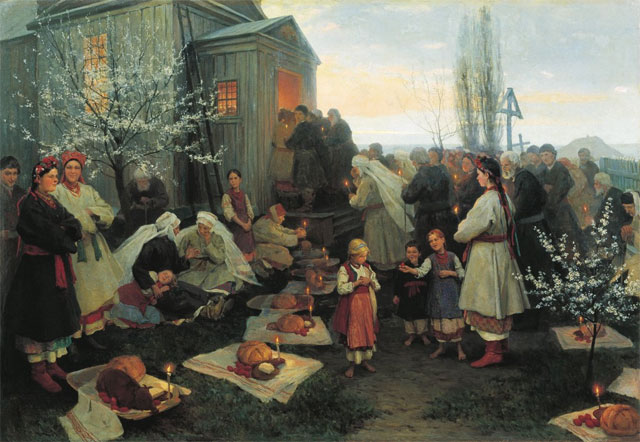
His real art training began in one of Kyiv's icon-painting workshops. But he went there not for a long time: there once he was remarked by Mykola Murashko - founder and head of the Kyiv Drawing School, which lasted from 1875 until 1901, and soon young Pymonenko became its student. But it's easy to write - "soon became". In fact, everything was not very easy: his father had no money for tuition, so the fate of talented young boy was jointly decided by Murashko and one of the main patrons of the school Ivan Tereshchenko. And the guy was taken and released from tuition fees.

There should be at least briefly recall this institution. Kyiv Drawing School was the first art school in Kyiv. Of course, it was private, because the then (as, indeed, the present) Kyiv authorities had no desire to deal with the issue of artistic education of youth, as well as they had no interest in Ukrainian culture at all. The school was established by yesterday the Imperial Academy of Arts student Mykola Murashko. He had to leave Petersburg because of ill health before the end of the study.The school began to work in a private apartment Murashko, and a year later was recognized by the Ministry of National Education. It was supported by colleagues Murashko: tutorials, paintings and sketches of famous Russian painters and their own work were sent by Ivan Kramskoy, Gregory Myasoedov, Konstantin Makovsky, Ilya Repin, Vasily Polenov, Arkhipov Kuindji Vladimir Orlovsky, and other famous artists. Pretty soon the school became the real center of artistic life, not only in Kyiv, but also a large part of the South-West region, then known as the Ukraine. There was created a wonderful school museum of paintings and graphics, its leaders organized and participated in the preparation of urban art exhibitions and so on. In addition to thorough training in drawing and painting, the students of the Murashko school received school and general knowledge: The curriculum includes plastic anatomy, art history, literature and others.
Pimonenko started attending drawing school in 1878 and immediately distinguished himself as one of the most talented students. So a year later he began to help teachers: he was entrusted to conduct classes in drawing with the younger students. And two years later he passed an exam for the title of teacher of drawing in the lower schools at the Kyiv district school. His examination papers were sent to the St. Petersburg Imperial Academy of Arts, where they were found to allow the author to assign them the title.
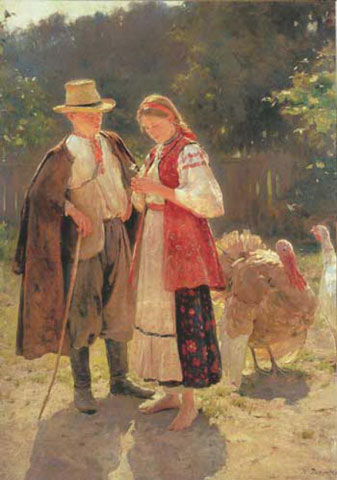
In the following 1882 Pymonenko was admitted in the Academy of Arts as a volunteer. Very quickly he took the first classes (courses) of study - plaster heads, plaster figures and was upgraded to a full-scale. His classmates at full-scale class were Valentin Serov, Mikhail Vrubel, Sergei Vasilkovsky. However due to lung disease, which evolved in him for an "unfriendly" for many immigrants from Ukraine climate "Northern Capital" and serious material deprivation, he was forced to quit school and go back to Kyiv. His house was here, here the teaching at the School of Drawing and own creative path were waiting for him. And he returned home and began working in the Murashko school. Among his pupils there were such famous later artists as Sergei Kostenko, Olexander Murashko, Photios Krasitsky, Gregory Svitlitsky and others. It is known that his classes were attended by a very young at that time Lesya Ukrainian.
Pimonenko considered "gallery" as his first independent picture, it was written in 1885. Its heroes - ordinary people who do not have money for a place in the orchestra, but ardently love art. Although the picture was still not without some drawbacks, primarily in way of too straight and supply of images, it has determined the further career of its author and his sympathies in the choice of heroes.A significant number of his paintings subject, composition and ideologically are relevant to the socio-artistic principles of itinerants with their fidelity to the truth of life and sharply negative attitude to the disease of society. Since the early 90-ies of the XIX century, he began to participate in the exhibitions of the Association of Traveling Art Exhibitions (mobile exhibitions, as they were exhibited in many cities of the empire, hence the common definition of the members of the Society - "Itinerants")- popular Russian art association late XIX - early XX centuries, and in 1899 he became its member. Therefore, by the way, some researchers have subsequently accused him of excessive everyday genre and social blinders (in truth, to some extent inherent in some adepts if Itinerants). However, it is through participation in the activities and exhibitions of the Society of the Pymonenko quickly acquired extraordinary popularity across the country. And the people knew not only his paintings to exhibitions, but also reproductions, which were published in magazines and on separate cards.
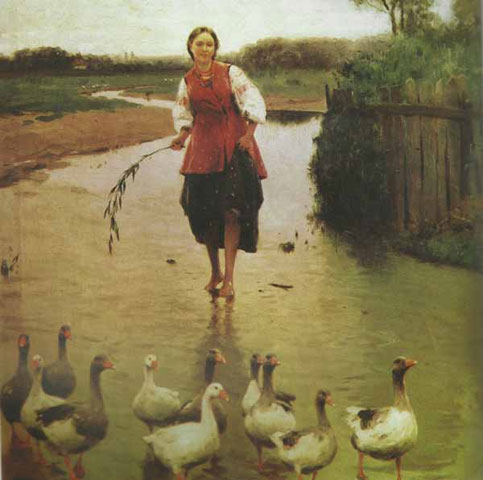
Despite this fame, all his life Pymonenko persistently improving his skills. His wife Olexandra (incidentally, the daughter of his teacher at the Academy of Vladimir Orlovsky) recalled: "He always carried a little box with canvas, brushes and paints and a small album with a pencil." It is worth noting that the outstanding artist Orlovsky opposed itinerants’ "bias" was a supporter of the academic school romantic landscape, but at the same time, was following the French Barbizon school. However, despite the contradictions in the views on the role and tasks of art, the relationship of Pymonenko with his father in law were extremely welcoming. Friendship enriched both: with years Orlovsky is moving away from strict academic, Pymonenko - greatly expanded the visual tools and enriched his palette. Communication of two great masters was very close: the summer of 1897, Academician Orlovsky left Petersburg and moved to his native Kyiv, where he bought a farm, where he constructed a small house for Pymonenko family(manor house by the address - 28, Gogol street survived until now, the memorial plaque is hanging on the door).
Pimonenko sometimes is called the "singer of the Ukrainian village."And it is certainly true. Children's impressions from trips with his father, love for one's homeland is reflected in many of his genre works devoted daily life, the joys and concerns of ordinary people. Much of this work was written in Malyutintsy near Kyiv, where the artist lived with his family every summer and where he equipped with a workshop. His "Wedding in the province of Kyiv" (1891), "Matchmakers" (1893), "Divination" (1893), "At the Well (Boys)" (1894), "On the Fair" (1898 ..), "Wade" (1901), "Geese, go home!", "Rivals. At the Well" (1909), "Gopak" and many others are a clear indication of his love for Ukraine and a deep knowledge of the daily life of working people. Lyricism, which permeated every stroke of the wizard displays the true love of his heroes. Incidentally, the last of these paintings in 1909 were acquired by the Louvre, and Mykola Pymonenko for this painting was awarded the gold medal of the Salon de Paris, the Society of French Artists. He painted also on historical motives: his view of the past - as a folk song about the Cossacks.
However, the creative legacy Pymonenko is much wider than that approved in the minds of many art lovers scheme. He painted beautifully on urban motifs – the witnesses are his "Meeting with countryman" (1908), 1897 and 1908 versions, "Kyiv florists", full of poetry"Exit of the church in the Holy Thursday," "Conversation" and other works. However, unfortunately, even in the main exhibition of the National Art Museum of Ukraine with 12 paintings only 2 are on the urban subjects. More precisely they are about Kyiv, because all his life Pymonenko lived in Kyiv.
But there were also quite charming, loving portraits of children and wives, simple peasants and famous Kyiv. And yet –there are wonderful graphic illustrations of Shevchenko poems, drawings to other books. We should not forget that Pymonenko was one of Kyiv artists who in 1890 participated in the painting of the cathedral in Kyiv. He fulfilled the images of St. Anne and Mykola of Myra, and some images on the pediment. In 1897 he received for these murals Order of St. Anne III degree.
From picture to picture his technique was perfected- the daily observation of life and work in the open air alongside Orel watered his painting air, sunshine and joy of life. Father in law was surprised versatility and talent Pymonenko, according to the memoirs of his wife, called it "complex" because he still wrote a great people, landscapes, flowers, animals, that is - the whole world around him. His work did not go unnoticed, they willingly were taken on an exhibition in Berlin, Paris, London and Munich. Beside the member of the Association of Traveling Exhibitions, he became a member of the Association of South Russian Artists, Society Munich artist and Paris international alliance of arts and literature. And in 1904, the Council of the Imperial Academy of Arts "for fame in the artistic field," awarded him the title of academician of painting.
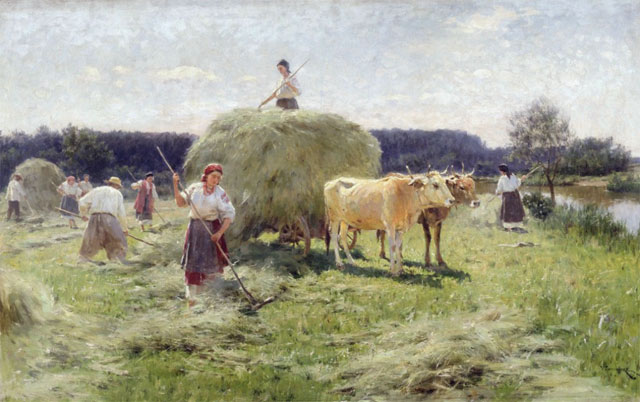
However Mykola Pymonenko didn’t stop the teaching. By early 1901 he was a professor of Drawing School, and after its closing became a full-time teacher of drawing the Kyiv Polytechnic Institute, where he worked until the very end of his life. In the KPI, he enjoyed great respect: for the many years of work his picture "full-length" was even posted in the auditorium of the Institute . However, despite the award, rank and fame, he was always a really popular artist, author of hundreds of paintings, which are presented to the world his native Ukraine and its people.
Mykola Pymonenko died March 26 (April 8), 1912. The legacy left behind by this tireless worker - is enormous. A significant number of his paintings and drawings are stored in the National Art Museum of Ukraine - not only, of course, in the main exhibition, but also in the vaults. Now on the occasion of the 150 anniversary of The Wizard is a large exhibition of these works is prepared. The opening is scheduled for the second half of this year. I am sure that it will not leave indifferent anybody.
Photo:
1. Mykola Pymonenko
2. Yule divination
3. Kyiv florist
4. Geese home!
5. On the River
6. Idyll

